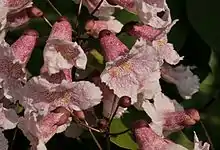榎
| ||||||||
Translingual
Han character
榎 (Kangxi radical 75, 木+10, 14 strokes, cangjie input 木一山水 (DMUE), four-corner 41947, composition ⿰木夏)
References
- KangXi: page 542, character 21
- Dai Kanwa Jiten: character 15219
- Dae Jaweon: page 930, character 28
- Hanyu Da Zidian (first edition): volume 2, page 1263, character 2
- Unihan data for U+698E
Chinese
| trad. | 榎 | |
|---|---|---|
| simp. # | 榎 | |
| alternative forms | 檟/槚 | |

Glyph origin
| Old Chinese | |
|---|---|
| 榎 | *kraːʔ |
| 廈 | *sraːs, *ɡraːʔ |
| 嗄 | *sqʰraːs, *qraːds |
| 夏 | *ɡraːʔ, *ɡraːs |
Pronunciation
Definitions
榎
- The Manchurian catalpa, Catalpa bungei.
Japanese
Kanji
(“Jinmeiyō” kanji used for names)
Readings
- Go-on: け (ke)
- Kan-on: か (ka)
- Kun: え (e, 榎); えのき (enoki, 榎)
Compounds
- 榎草 (enokigusa)
- 榎茸 (enokitake): enokitake
- 榎寺 (enokidera)
- 榎の実 (enomi)
- 榎本 (Enomoto): A surname.
- 椋榎 (mukuenoki)
Etymology 1

| Kanji in this term |
|---|
| 榎 |
| え Jinmeiyō |
| kun’yomi |
From Old Japanese. Found in the Man'yōshū, completed some time after 759 CE.[1]
There are various theories regarding the ultimate derivation of this e. Some of these include:
- From 枝 (e, eda, “branch”), from the many branches
- From 餌 (e, esa, “food for animals”), from the multitude of berries eaten by birds
- From 柄 (e, “handle”), from the way the wood was used for tool handles
Pronunciation
- Kun’yomi
- IPA(key): [e̞]
Noun
榎 • (e)
- Celtis sinensis, the Chinese hackberry tree
- Synonym: (see below) 榎 (enoki)
- (rare) the Chinese hackberry fruit
- Synonym: 榎の実 (e no mi, enoki no mi)
Usage notes
This reading is generally not used in isolation in modern Japanese.
Etymology 2
| Kanji in this term |
|---|
| 榎 |
| えのき Jinmeiyō |
| kun’yomi |
Compound of 榎 (e, “Chinese hackberry”) + の (no, possessive particle) + 木 (ki, “tree”). Compare the similar formation of various other tree names, such as 楠 (kusu, “camphor; camphor tree”) and 楠 (kusunoki, “camphor tree”).
Alternative forms
- 朴
- 𪱻
Pronunciation
- Kun’yomi
- (Tokyo) えのき [ènókí] (Heiban – [0])[2][3]
- IPA(key): [e̞no̞kʲi]
Noun
榎 • (enoki)
- Celtis sinensis, the Chinese hackberry tree
Proper noun
榎 • (Enoki)
- a surname
Usage notes
As with many terms that name organisms, this term is often spelled in katakana, especially in biological contexts (where katakana is customary), as エノキ.
References
- c. 759, Man'yōshū (book 16, poem 3872), text here
- 2006, 大辞林 (Daijirin), Third Edition (in Japanese), Tōkyō: Sanseidō, →ISBN
- 1998, NHK日本語発音アクセント辞典 (NHK Japanese Pronunciation Accent Dictionary) (in Japanese), Tōkyō: NHK, →ISBN
Further reading
Etymology at Nihonjiten (in Japanese)
Korean
Hanja
榎 • (ga) (hangeul 가, revised ga, McCune–Reischauer ka, Yale ka)
- This term needs a translation to English. Please help out and add a translation, then remove the text
{{rfdef}}.